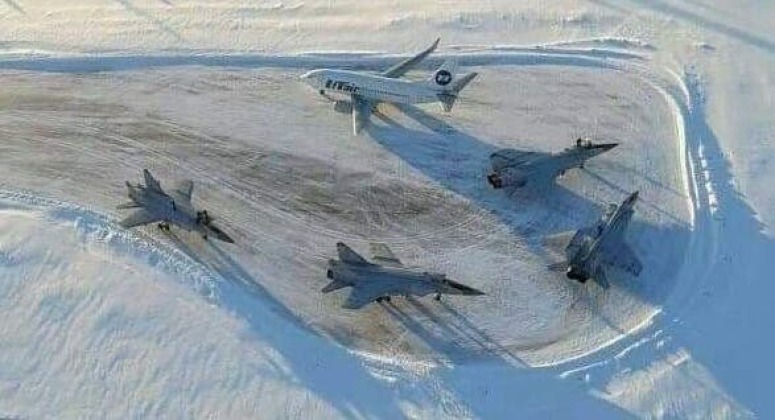News
MiG-31s Demonstrate High Altitude Interception Capabilities in Far North: What is the Foxhound’s Role and Future in Russian Service?
MiG-31 interceptors deployed by the Russian Navy’s Northern Fleet practiced interception of enemy aircraft at high altitude over the Barents Sea, with the fleet’s press service reporting on November 7: “The crews of MiG-31 fighters of the Northern Fleet’s separate combined air regiment have practiced interception of a hypothetical enemy in the stratosphere. According to the drills’ scenario airspace monitoring means detected an air target approaching Russia’s state border over the Barents Sea… The crews identified the air target and escorted it over the Barents Sea, forcing the hypothetical intruder to turn away from Russia’s state border.” A MiG-31 from a separate mixed air regiment of the Northern Fleet was assigned to simulate the position of an intruder into Russian airspace. Although the large majority of MiG-31s in Russian service are deployed by the Russian Air Force, which fields well over 100 of the aircraft, an estimated 32 more are deployed under the Northern Fleet – approximately two thirds in a full MiG-31 regiment and around 10 airframes in a mixed regiment with Su-24M strike fighters.

MiG-31s from the Northern Fleet have shouldered a growing burden over the Barents Sea in the face of expanding NATO capabilities in the region, and in particular the Norwegian Air Force’s transition from F-16 to F-35 fighter aircraft which have revolutionised its combat capabilities. While the MiG-31 retained overwhelming performance advantages over the F-16, which was under one third its size and carried a radar under one sixth the size of its own, the F-35’s stealth capabilities and much more advanced sensors, avionics and weaponry have threatened to shift the balance of power considerably. Russia’s position is set to worsen considerably once ongoing issues with the F-35s are resolved, as the problematic American fighter class is still far from capable of high intensity combat. Norway’s neighbour Finland, which joined NATO in April, is set to replace its F-18s with multiple squadrons of additional F-35s, while large U.S. Air Force deployments to bases on Finnish territory are also under discussion.
Encounters between MiG-31s and Norwegian Air Force aircraft have been far from uncommon, a notable example being the interception of a P-3C Orion reconnaissance plane over the Barents Sea on December 12, 2022. Other than a small number of new Su-57 stealth fighters, the MiG-31 is widely considered Russia’s most capable combat aircraft for air to air combat, and recently saw its first engagements over Ukraine with both MiG-31K strike variants and MiG-31BM/BSM interceptor variants demonstrating particularly strong performances and gaining multiple kills.

Designed to be able to operate above the Armstrong Limit and fire all its weapons in near space, the MiG-31’s R-37M air to air missiles with extreme 400km ranges, unmatched Mach 6 speeds and very large 60kg warheads make them particularly dangerous against targets at all altitudes. The sheer power of their sensors made them the first combat aircraft in the world capable of long range interceptions against low flying cruise missiles. The interceptors have also been prioritised for integration of R-74 short range air to air missiles, which help to compensate for their limited low manoeuvrability by allowing pilots to target adversaries at extreme angles without needing to turn the airframes themselves. Although comprehensive upgrades to the fleet proposed in the 1990s were never applied due to budgetary shortages, the MiG-31’s capabilities were revolutionised from 2009 and throughout the 2010s with upgrades bringing the aircraft up to the MiG-31BM/BSM standard, which included integration of an entirely new radar and avionics. As the importance of operations in the Arctic has continued to grow, the MiG-31’s high suitability for operations in extreme climates including its ability to operate from ice airfields and very long range and high situational awareness has only increased the class’ perceived importance.
The future of the MiG-31 fleet remains highly uncertain, and while successors to the Foxhound were developed under the MiG-31M, Project 701 and the PAK DP programs the former two were cancelled and the state of the latter remains unknown. The possibility has thus grown that the MiG-31 may be retired without replacement by an equivalent interceptor class. With Russia relying increasingly heavily on ground based systems for long range air defence, such as the S-500 system now in large scale production, it has been increasingly speculated that Su-57 fighters – possibly as a modified extended range twin seater variant – could eventually replace the Foxhounds.












